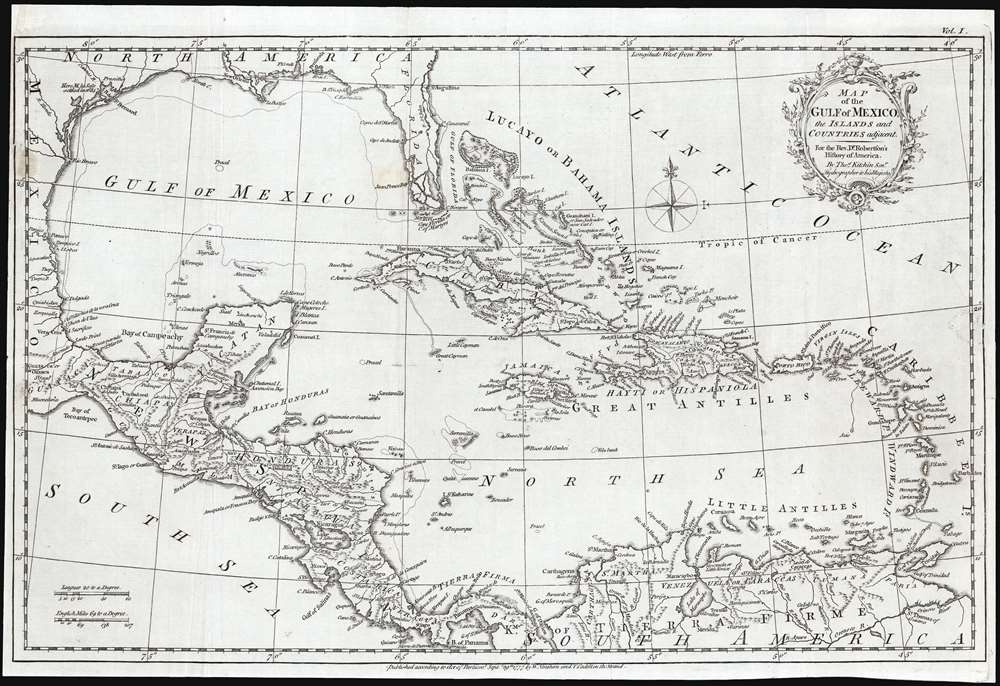This item has been sold, but you can get on the Waitlist to be notified if another example becomes available, or purchase a digital scan.
1777 Kitchin Map of the Gulf of Mexico and the Caribbean
GulfCaribbean-kitchin-1777
Title
1777 (dated) 12.5 x 19.25 in (31.75 x 48.895 cm) 1 : 9000000
Description
Kitchin's Source
Kitchin's source for his map is French, specifically, Jean-Baptiste Bourguignin d'Anville's 1746 Amerique Septentrional. The very distinctively skinny Florida appearing here, the relatively accurate rendition of the Bahamas, the long sandbars connecting Grand Cayman with the Isla Pinos, and connecting Saba with 'Avis' in the Leeward Islands all point to a close relationship with the D'Anville map. Kitchin was not alone in his esteem of D'Anville's cartography. Many of the English engravers of the late 18th century relied on the French mapmaker as a source for the maps they produced for England's fast-moving publishing industry.The map is beautifully engraved, with mountains represented pictorially and the coastlines emphasized with hachure. It is embellished with an herbal-themed cartouche, and an elegant, simple compass rose.Publication History and Census
This map was prepared by Thomas Kitchin for inclusion in the 1777 edition of William Robertson's History of America, published in London by William Strahan and Thomas Cadell. Robertson's History was reprinted several times, and this map appeared without change to the date in both the 1784 and 1792 editions of the book. In 1795 the date on the map was changed, and examples from that date onwards bear the 1795 date. We see perhaps nine or ten examples of the separate map catalogued in institutional collections; the book itself is well represented in OCLC.CartographerS
Thomas Kitchin (August 4, 1718 – June 23, 1784) was a London based engraver, cartographer, and publisher. He was born in London to a hat-dyer of the same name. At 14, Kitchin apprenticed under Emanuel Bowen, under whom he mastered the art of engraving. He married Bowen daughter, Sarah Bowen, and later inherited much of his preceptor's prosperous business. Their son, Thomas Bowen Kitchin, also an engraver joined the family business, which thereafter published in Thomas Kitchin and Son. From 1858 or so Kitchin was the engraver to the Duke of York, and from about 1773 acquired the title, 'Royal Hydrographer to King George III.' He is responsible for numerous maps published in the The Star, Gentleman's Magazine, and London Magazine, as well as partnering with, at various times, with Thomas Jefferys, Emmanuel Bowen, Thomas Hinton, Issac Tayor, Andrew Dury, John Rocque, Louis de la Rochette, and Alexander Hogg, among others. Kitchin passed his business on to his son, Thomas Bowen Kitchin, who continued to republish many of his maps well after his death. Kitchin's apprentices included George Rollos, Bryant Lodge, Thomas Bowen Kitchin, Samuel Turner Sparrow, John Page, and Francis Vivares. More by this mapmaker...
Thomas Cadell the elder (November 12, 1742 - December 27, 1802) was an English publisher and bookseller. Born in Bristol, Cadell was apprenticed to a London bookseller named Andrew Millar in March 1758, and became Millar's partner in April 1765 after finishing his seven-year apprenticeship. He took over the business with the help of Millar's assistant following Millar's death in 1768. Not only was Cadell a successful bookseller, but he also found success in publishing, publishing poetry by Robert Burns, and works by jurist William Blackstone, economist Adam Smith, and Edward Gibbon's Decline and Fall of the Roman Empire. Cadell married the daughter of Reverend Thomas Jones on April 1, 1769, with whom he had two children, a son and a daughter. Cadell retired in 1793 and his son, Thomas Cadell the younger (1773 - 1836), took over the business. Cadell died at home of an asthma attack on December 27, 1802. Learn More...

